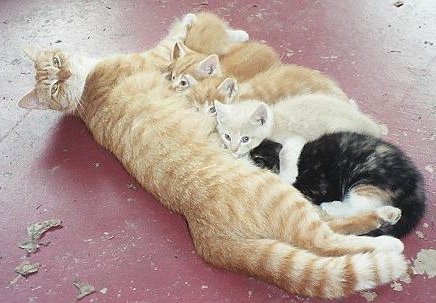Feline reproduction
Cats are prolific breeders. Females take just 6 to 9 months to reach sexual maturity; but it is not unheard of for female kittens as young as 4 months to become pregnant. Males mature a bit later but both sexes can breed before they are a year old. Although female can become pregnant at any time of the year, there are specific mating seasons when cats become sexually active. In northern Europe it is usual for domestic female cats to come into heat (oestrus cycle) in January and then again in June.The oestrus cycle is the period in the female reproduction cycle when mating is most likely to occur. A heat period lasts about 4 to 7 days if the cat is mated, and longer otherwise. Female cats indicate their readiness to mate by calling for male company with a special type of yowl, which like the (highly vocal) mating itself has often disturbed the sleep of humans who live in the vicinity.
One of the most interesting features of the reproductive process of cats is a phenomenon known as induced ovulation. The male cat's penis has backward pointing spines which scratch the interior of its partner, and cause ovulation to occur. Because pregnancy will not take place without this stimulus, quite often the first cat to mate with a queen with not father any kittens. However, the super-fertility of cats means that once she gets started, the female is capable of having a number of partners, and bearing kittens from several fathers in the same litter. The mother's eggs are fertilised in the oviduct and arrive in the uterus 4-5 days after mating. Cats do not go about the process quietly, and to the unpractised ear the process sounds remarkably like a prolonged and very vocal cat-fight.
Pregnancy lasts between 56 and 71 days, with the average pregnancy taking 68 days. Litters are most commonly of 3-6 kittens, but a single litter may have as many as nine. The record was a litter 19 kittens; the mother being a Burmese/Siamese cross from Oxfordshire in England. The kittens were born on the 7th of August. Unfortunately four of the kittens were stillborn.

Let's meet at the milk bar
A few days before she is due to give birth the pregnant female will become restless and will look for the best nest. This will normally be quiet, warm and in one of the darker parts of the house. This is where she will give birth. It is a good idea not to disturb her in her nesting place.
Kittens are both blind and deaf when born but otherwise well developed. They are, for example, more responsive than newborn puppies. A newborn kitten has a very good sense of smell and she will soon select a teat to feed from and will suck at no other. A kitten will be ready to play at three weeks old and will be fully weaned by 8 weeks. The mother can come into heat as soon as four weeks after giving birth. If the kittens are pedigreed, the father is referred to as the 'sire' and the technical term for the mother is the 'dam'.
As we said earlier cats are prolific breeders and can breed throughout their lifespan. Again dipping to a feline book of records we will find that the most prolific breeder ever recorded was a tabby from Texas, USA called Dusty. She produced 420 kittens, the last litter being in 1952. Although fertility may gradually decline over time, cats do not go through "the menopause". Therefore there is no age after which a female cat can no longer become pregnant. Indeed the oldest cat to have a litter was Litty, who gave birth to two kittens in May 1987 when she was 30 years old.
With this birthrate it is no wonder than left to itself the feline population will quickly run out of control. It has been estimated that in a 12-year lifespan, without human intervention, a single female cat could be responsible for as many as 3500 descendants. There are already too many cats born each year and sadly, many are destroyed. It is therefore important that the cats are neutered as early as possible. Nuetered cats are much better pets and studies have also shown that females spayed before they are six months have a significantly reduced risk of mammary (breast) cancer. It is also the case that if male cats are spayed later, they may continue aggressive scent-marking (spraying with urine), out of sheer force of habit.
